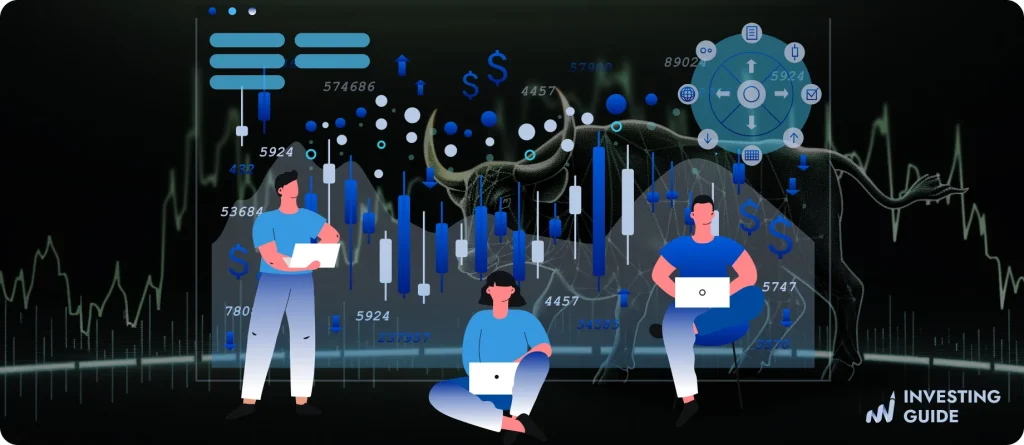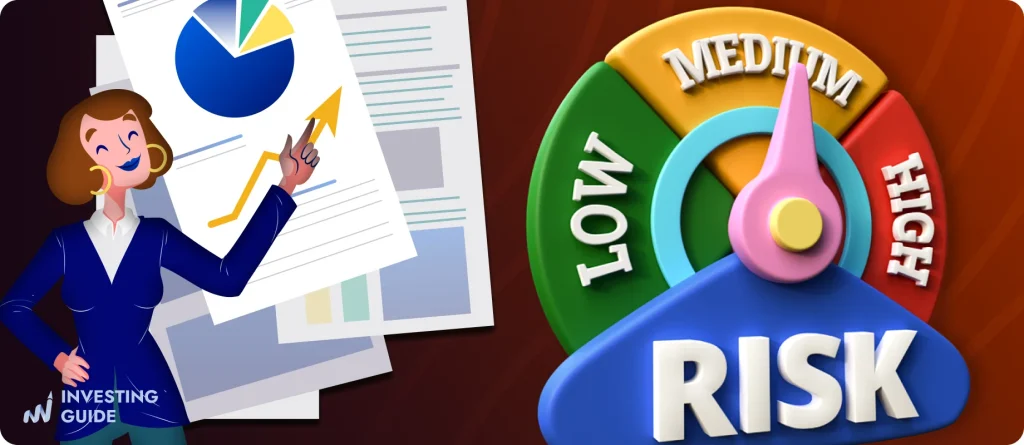Yulia Pavliuk is a financial content writer with a background in language, education, and clear communication. She creates SEO-friendly articles that make complex finance topics like ETFs and forex signals clear and accessible, with a strong focus on UK audiences.
We may receive compensation from our partners for placement of their products or services, which helps to maintain our site. We may also receive compensation if you click on certain links posted on our site. While compensation arrangements may affect the order, position or placement of product information, it doesn’t influence our assessment of those products.
A stock chart flashing green one moment and red the next. Headlines about crypto millionaires, market crashes, and soaring interest rates. For beginners looking at the trading world from the outside, it can feel more like a casino than a financial system. The idea of beating the market is seductive – but without a clear, disciplined strategy, most newcomers get caught in the churn.
What separates those who quietly succeed from the many who quietly quit? It’s not instinct, nor flashy predictions. Its structure. Successful traders treat trading like a craft. They commit to a method that suits their mindset, time, and risk tolerance, and they refine it, trade by trade. This article examines several proven trading strategies and explains how each works in practice, enabling you to begin with confidence and purpose.
What Do We Mean by Trading Strategy?

A trading strategy is not a tip or a gut feeling. It’s a systematic approach to buying and selling financial assets – be that stocks, forex, commodities, or derivatives. A strategy outlines when to enter a trade, when to exit, and how to manage risk along the way.
While long-term investing often involves buying and holding solid assets, trading is typically a more short-term and tactical approach. Some strategies take a few days to complete; others can be done within minutes. But all credible trading strategies share key ingredients:
- A market focus (technical, fundamental, or a blend)
- A defined timeframe
- Position sizing and risk limits
- Exit rules, both for profits and losses
The aim isn’t to find the perfect strategy. It’s about finding one that suits your life, temperament, and goals.
How Swing Trading Works
Swing trading aims to profit from short- to medium-term price moves. Trades are typically held for several days or weeks, allowing you to participate in market swings without the intensity of real-time trading. Traders often rely on technical patterns, moving averages, and support/resistance levels.
What you should know:
- Works well alongside a day job; trades don’t require constant monitoring.
- Best suited to those who can analyse charts and stick to a plan.
- Helps develop emotional discipline and chart-reading skills.
- Risk can be managed clearly with stop-loss and target levels.
- Often used in conjunction with equities, forex, and commodities that exhibit identifiable trends.
How Day Trading Works
Day trading involves buying and selling financial instruments within the same trading day – no positions are held overnight. Traders use short-term charts (1–15 minutes) and aim to profit from small intraday price moves. This method is high-frequency and typically requires quick decision-making.
What you should know:
- Demands full-time focus and high mental stamina.
- Spreads and fees can quickly add up; therefore, low-cost brokers are essential.
- Mistakes compound quickly, so a clear plan and stop-loss are vital.
- Best suited to those with time, fast reflexes, and emotional control.
- Requires reliable hardware, fast internet, and trading software with minimal latency.
How Trend Trading Works
Trend traders seek to identify a sustained price movement – either upward or downward – and trade in the direction of that movement. They typically use longer-term charts (daily or weekly) and tools like moving averages, volume, and trendlines.
What you should know:
- Requires patience; trades can last weeks or even months.
- Works best in clearly trending markets like forex or major indices.
- Simple to understand conceptually, but emotionally challenging.
- Avoid trying to predict reversals—ride trends until they break.
- Suitable for traders who prefer structure over speed and enjoy following broader economic narratives.
How Algorithmic Trading Works
Algorithmic (or “algo”) trading uses pre-programmed rules to execute trades automatically. These rules are based on price, volume, timing, or other mathematical models. Once set up, the algorithm scans the markets and places trades without human intervention.
What you should know:
- Eliminates emotional decision-making and improves consistency.
- Requires basic coding knowledge or access to reliable automation tools.
- Ideal for tech-minded traders who value structure and data.
- Backtesting and demo accounts are critical before going live.
- Increasingly accessible with tools like TradingView scripts, MetaTrader, and cloud-based platforms like QuantConnect.
How Scalping Works
Scalping is an ultra-short-term strategy focused on making dozens or hundreds of trades each day. The goal is to capture small price movements, often just a few pips or pence, relying on tight execution and high liquidity.
What you should know:
- Not beginner-friendly due to speed and stress levels.
- Requires ultra-low spreads, fast internet, and reliable execution tools.
- Even small mistakes or slippage can erase gains.
- Suitable only for traders who enjoy intensity and have time to focus.
- Most effective in highly liquid markets, such as major forex pairs or FTSE 100 stocks.
How Position Trading Works
Position traders take a long-term view—holding positions for weeks, months, or even years. They base decisions on fundamental factors such as interest rates, economic trends, or corporate earnings, often supported by long-term chart analysis.
What you should know:
- Less screen time and stress than short-term strategies.
- Suitable for those with a strong interest in macroeconomics and a long-term perspective.
- Works well with blue-chip stocks or major currency pairs.
- Profits may come slowly but steadily – if your thesis holds (remember, your capital is at risk).
- Often overlaps with long-term investing, but still requires planned exits and disciplined risk control.
How News-Based Trading Works
News trading involves making trades based on economic releases, political developments, or breaking headlines. It relies on speed and anticipation – traders aim to capture market reactions in the minutes or hours following major events.
What you should know:
- News-driven markets can be highly volatile – prices may shift sharply with little warning.
- Requires a good news feed and the ability to interpret headlines fast.
- Works well in forex and indices, where economic data has an immediate impact.
- Risk management is crucial, as slippage and reversals are common.
- Events like UK interest rate announcements or US Non-Farm Payrolls (NFP) are popular triggers.
How Range Trading Works
Range trading works on the principle that asset prices tend to fluctuate between identifiable high and low levels, known as resistance and support. Traders using this method aim to enter positions near the lower boundary and exit near the upper limit, profiting from the price moving back and forth within this range.
What you should know:
- Best in low-volatility markets without strong trends.
- Ideal for traders who enjoy structured decision-making based on technical patterns.
- Requires constant attention to price zones and reversal signals.
- Works well in markets like certain currency pairs or consolidating stocks.
- Stop losses are essential to avoid getting caught in unexpected breakouts.
Understanding Risk Management

No matter how smart your strategy, it won’t last without risk control. Managing losses is not optional—it’s fundamental to long-term survival in trading.
What you should know:
- Use stop-loss orders to protect against unexpected moves
- Never risk more than 1–2% of your total capital per trade.
- Adjust your position size based on volatility and account size.
- Keep a trading journal to learn from both wins and losses.
- The FCA reports that over 70% of UK retail traders lose money, often due to poor risk management. Prioritise survival before performance
How to Choose the Right Strategy

There’s no single “best” strategy. The one that works is the one that suits you. Your personality, schedule, and goals will shape your ideal method.
Ask yourself:
- Do I have hours a day to trade, or just an hour in the evening?
- Am I calm under pressure or better with slow, structured analysis?
- Do I enjoy data, patterns, news, or long-term trends?
If you’re working full-time, swing or position trading may be the best option for you. If you’re analytical and tech-savvy, algorithmic strategies might be a natural fit. The key is to start with one approach and master it before moving on to the next.
FAQs
No. Many UK brokers let you start with £50–£100. But treat it as tuition, not investment capital. Use it to learn safely.
Start with a demo account or paper trading tool. Most UK platforms offer these. It’s the most innovative way to practise without financial risk.
Yes—but do it slowly. Make sure each strategy has its place. Many experienced traders employ swing trading strategies for stocks and trend trading for forex.
Step back. Review your trades. Focus on process, not profit. If needed, go back to demo trading until your edge returns.
Final Thoughts
No strategy is magical. Even seasoned traders lose money. What separates them is consistency, discipline, and self-awareness.
Trading strategies are tools. Used correctly, they give you structure, focus, and a method for measuring results. Used carelessly, they lead to random decisions and avoidable losses.


I spent my first few months randomly hopping between strategies, trying scalping one week and trend following the next, and just bleeding money without understanding why. It wasn't until I honestly assessed my own temperament and time availability that I settled on position trading